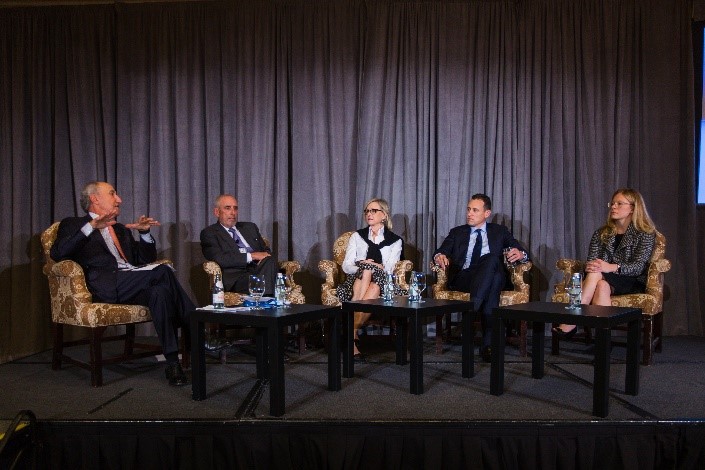Recessions, "Tourists" and the Future of CRE Finance

An insightful conversation at the DLA Piper 2019 Global Real Estate Summit brought together industry veterans to discuss the future of commercial real estate (CRE) finance, the role of discipline in stabilizing the CRE industry and the effects of retail technology in the market.
Moderator Mark Myers, Executive Vice President and Head of Commercial Real Estate at Wells Fargo, kicked off The Future of Real Estate Finance panel by outlining the magnitude of the mortgage market, which is worth roughly $3.5 trillion. Half of the market is held in the regulated commercial bank market and the rest is fairly divided between commercial mortgage-backed securities (CMBS), life insurers, government-sponsored enterprises (GSE) and other non-regulated lenders, Myers said in setting the stage for the conversation.
Despite the strong and varied market, the concern of a looming recession was a topic of conversation throughout the panel and appeared in the 2019 DLA Piper Annual State of the Market Survey. The annual survey of real estate experts found that 37 percent of respondents who had a bearish outlook of the CRE market cited what they viewed as the inevitable end of the latest positive cycle as a reason for their lack of confidence.
Tom Flexner, Vice Chairman Global Head of Real Estate Citigroup and a panel participant, acknowledged that the industry is living through a historically extended upward cycle while also indicating that the cycle could continue beyond expectations.
Future Recessions and REIT “Tourists”
The panelists agreed that changes in the CRE market alone would not cause another recession—although it would be impacted if the US experienced one. “There is very significant disciplined [behavior] in the market,” Greta Guggenheim, CEO and President of TPG Real Estate Finance Trust, pointed out. She noted there has been unsteady behavior in rates and lending in isolated cases, however, commercial banks, insurance companies and public mortgage rates have maintained tough discipline to avoid risky rates and any potential negative effects.
Jonathan Pollack, Blackstone Senior Managing Director and Global Head of Real Estate Debt Strategies, concurred and said that his team did not see many irresponsible leverage requests, a typical signal of a recession.
In addition to an anticipated recession, panelists discussed additional concerns impacting the market. The REIT market is also experiencing what Flexner dubbed “tourism.”
Flexner said that recently, the market “has attracted people we call tourists, which are the hedge funds.” These groups, he noted, focus on dividend growth and stock appreciation over net asset value, leading to a change in values in multiple property types and a decoupling of net asset value and public values.
When asked what markets or asset classes might face choppy waters in today’s market, Guggenheim said, “The most important thing is the alignment of interests between the lender and borrower. And if you have real skin in the game, that’s really important— keep that skin in the game until the property is showing some positive cash flow.”
In terms of risk, Flexner was more circumspect. “We try to focus on what we don’t know because the risks that you don’t even know about are the real ones,” he shared, as a continued nod to the need for disciplined behavior.
Technology: Yay or Nay?
There was also some debate across the panel over the role of technology in the CRE market.
Tiffany Thurber, Vice President of the Investment Banking Division at Goldman Sachs, noted that her group is still trying to figure out the structure around “B malls,” which are malls that make approximately $300-500 in sales per square foot, and how to align them to consumer preferences using technology. Therefore, retail technology was at the forefront of her thinking.
“On the technology side, there’s been a lot of growth in clothing rental companies,” Thurber said. “What’s interesting to me about this is it is sort of a digital version of a department store.” She pointed out that these services offer a mix of retailers and products and imagined a world in which today’s leading department stores “pick up some of this technology to tap into the next generation of people who are more accustomed to renting things.”
Guggenheim, however, saw limits to the role of technology in the CRE industry. “We’re still a people business and real estate is still a physical asset,” she said, adding that she did not see a clear path forward for scale on the internet aside from becoming more efficient through data collection.
What’s Next?
As the panel ended, Myers asked the panelists about the future of the finance industry and what elements may shape change.
Flexner noted one clear opportunity for change: Affordable housing. He opined that affordable housing or a lack thereof “could really change the real estate financing landscape.”
Myers enthusiastically agreed. “That will be a fascinating opportunity for those of us in finance,” he said. “If you’re not front and center, you need to be front and center.”
Opening the Toolbox for Success
To close, the group shared lessons learned from their careers. Flexner focused on the importance of people and pointed out that without good people, no business model could succeed. “As leaders, we have to create and sustain cultures that reward our people,” he told the audience.
Pollack added that shared accountability, trust, transparency and collaboration are Blackrock’s core principles. He revealed that the secret to Blackrock’s success was the most senior team members working the hardest and setting a precedent for commitment throughout the company.
Since becoming CEO, Guggenheim realized that having too strong of a personality in leadership could have a chilling effect on a business. “I’ve learned that it creates an environment where people stop innovating and creating if they’re not empowered,” she said, and offered that the most important factor for a team was “having a shared mission, purpose and goal.”
Thurber mentioned the vital role of “mentorship and having the right sponsorship,” especially among large teams such as her own, where people could otherwise slip through the cracks.
